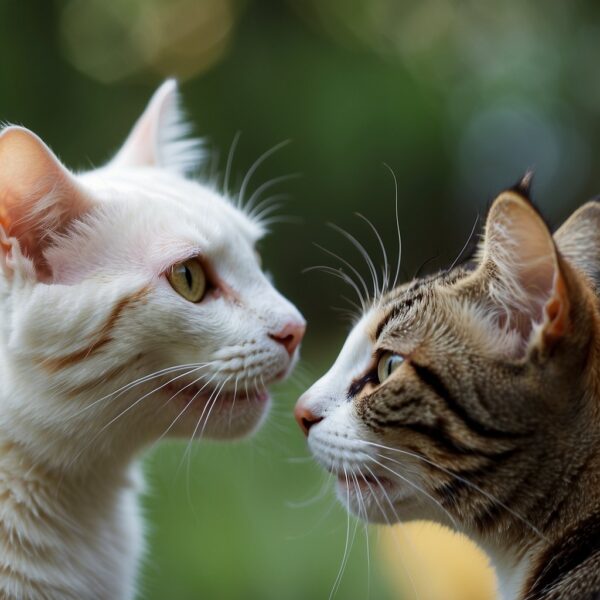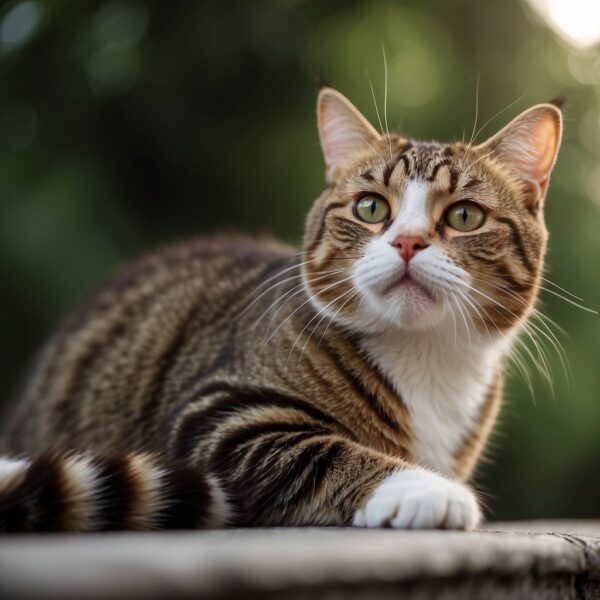
Cat Pheromones: Secrets of Feline Communication
Pheromones play a fundamental role in how cats interact with their environment and with each other. These chemical signals are secreted by animals and can trigger a wide range of behaviors and physiological responses in others of the same species. In cats, pheromones are used for communication, establishing territories, and creating feelings of comfort and security. Understanding pheromones is critical in addressing various behavioral issues and can be a valuable tool in both domestic and clinical settings.
Recent advances have led to the development of synthetic pheromones, which are designed to mimic natural cat pheromones and can be used to manage undesirable behaviors in cats. These products aim to alleviate stress, prevent aggression, and improve the overall welfare of cats. As research in feline pheromones continues to evolve, its applications in the field of veterinary medicine and animal behavior expand, providing both cat parents and professionals with new strategies for enhancing the lives of our feline companions.
Key Takeaways
- Cat pheromones are crucial for communication and behavior regulation in felines.
- Synthetic pheromones can be used to manage undesirable behaviors and reduce stress in cats.
- Ongoing research is expanding the applications of pheromones in veterinary practice and animal behavior.
The Role of Pheromones in Cat Behavior
Pheromones play a crucial role in the behavior and communication of cats. These chemical signals are secreted by glands in the cat’s body, including the facial pheromone glands, and are used to convey messages to other cats.
Communication through Pheromones: Cats use pheromones to mark their territory, signal reproductive status, and establish social hierarchies. For example:
- Territorial Messages: Cats may rub their cheeks against objects to deposit pheromones, marking the area as safe and familiar.
- Reproductive Signals: Sexually available female cats release specific pheromones to attract males.
Identifying Pheromones: The vomeronasal organ (VNO), located in the roof of a cat’s mouth, is instrumental in detecting pheromones. Behaviors such as the flehmen response, where the cat curls back its lips, facilitate the transfer of pheromones to the VNO.
Influence on Behavior: Pheromones can dramatically affect a cat’s emotional state and behavior. Positive pheromones can reduce stress during visits to the vet, while the presence of unfamiliar pheromones may lead to aggression or anxiety.
Synthetic Pheromones: Synthetic pheromones, such as Feliway, mimic natural cat pheromones and are used to manage behavioral problems and stress by creating a calming environment.
In summary, pheromones are essential to cat behavior, acting as unseen but influential communicators that shape social interactions and emotional wellbeing.

Types of Feline Pheromones
Cats communicate complex messages through chemical signals released by their bodies. These messages can influence the behavior of other cats and affect social interactions.
Facial Pheromones
Cats possess facial pheromones that are mainly associated with social interactions. Cats mark their environment by rubbing their cheeks and head against objects, people, or other animals, a behavior known as bunting. These feline facial pheromones convey comfort and familiarity, helping to establish territory and reinforce social bonds. Synthetic pheromones, such as Feliway, mimic these chemicals to reduce stress in cats.
Interdigital Pheromones
When scratching, cats release feline interdigital semiochemicals from glands located between their paw pads. This scratching behavior serves the dual purpose of marking territory and maintaining claw health. The pheromones deposited communicate the presence and identity of the scratching cat to others, thus playing a crucial role in territorial marking.
Mammary Gland Pheromones
Referred to as cat-appeasing pheromones, these are emitted by mother cats during lactation to calm and reassure their kittens. This particular pheromone indicates safety and promotes bonding between the mother and her offspring. It can be synthetically replicated to help reduce stress-related behaviors in cats of all ages.
Territorial Pheromones
Cats utilize territorial pheromones to establish boundaries and convey identity. Common behaviors include urine spraying and urine marking, where specific pheromones are released to delineate territory. Male cats often display these behaviors more frequently, potentially due to the presence of the compound felinine in their urine, which serves as a marker of sexual and territorial presence.

Pheromones and Cat Communication
Pheromones play a crucial role in how cats interact with their environment and convey information to other cats. Through a variety of behaviors and signals, these chemical messengers assist in maintaining social order within feline communities and influence the behavior of individual cats.
Scent Marking Behaviors
Cats use scent marking to communicate ownership and establish their territory. This is done through behaviors such as spraying urine and allorubbing, where a cat rubs its head or body against objects or other cats to transfer scent from glands located on their cheeks and other body parts. This form of chemical communication is vital for conveying messages about a cat’s presence and reproductive status to others in the area. The well-documented flehmen response, where a cat curls back its lips and inhales, allows for the detection of pheromones and other scent-based signals.
Nonverbal Cues and Signals
In addition to chemical signals, cats use a complex system of nonverbal communication to express their emotions and intentions. Tail position, ear orientation, and overall body language are key indicators of a cat’s mood. For instance, a high, erect tail usually signifies a friendly disposition, while hissing and chasing are direct displays of aggression. These physical cues supplement pheromone signals and help cats navigate interactions with other cats, especially in multi-cat households or colonies.
Influencing Social Dynamics
Pheromones have a profound effect on the social dynamics within a cat community, helping to reduce tension and inter-cat aggression. Synthetic pheromones, like those found in products modeled after the F3 fraction of feline facial pheromone, are used to create a sensing of calming in domestic cats. They can simulate the natural pheromones cats release when they feel safe, thereby reducing stress and aggression in multi-cat households. Scent marking through facial rubbing, commonly referred to as allorubbing, is a friendly behavior that promotes bonding and peace among cats.

Cat Pheromones and Stress Reduction
Cat pheromones play a significant role in the reduction of stress and anxiety in felines. Synthetic pheromones mimic natural calming signals, offering a strategic approach to managing stress-related behaviors.
Calming Effects on Individual Cats
Synthetic feline pheromones are designed to replicate the reassuring signals given off by cats themselves. These pheromones can have a tranquilizing effect on individual cats experiencing stress or anxiety in stressful situations such as moving to a new environment or the introduction of new pets. Studies have reported reduced signs of feline stress such as hiding or excessive scratching when exposed to a calming pheromone diffused in their environment.
Managing Multi-Cat Household Tensions
In multi-cat households, the presence of multiple animals can create a complex social environment, often leading to tension and aggressive behaviors. Utilizing pheromone-based products such as diffusers or sprays can help in tension reduction and create a more harmonious atmosphere, leading to less conflict and reduced stress markers.
Impact on Stress-Related Behaviors
Cats under stress may exhibit a range of undesired behaviors including inappropriate urination and inappropriate scratching. Pheromone therapy has been observed to address these stress-related behaviors by emitting signals that cats associate with safety and comfort, thereby reducing the frequency of these actions. However, it’s important to note that while chemical signals can be effective, they should be part of a comprehensive approach that includes environmental and behavioral modifications.

Commercial Pheromone Products and Applications
Commercial cat pheromone products are designed to manage behavioral issues and stress in cats by mimicking their natural chemical signals. These products come in various forms such as diffusers, sprays, collars, and wipes, each serving different applications and suiting various environments.
Diffusers and Sprays
Pheromone diffusers, such as the Feliway Classic plug-in diffuser, release synthetic feline facial pheromones into the environment to create a calming effect. These diffusers are typically used within the home and can cover an area up to 700 square feet. Pheromone sprays are used for targeted areas, such as bedding or carriers during transport, with the aim to reduce stress-related behaviors.
- Feliway Multicat: A diffuser designed to reduce intercat aggression and tension in multi-cat households.
- Spray Applications: Used for travel or visits to the veterinarian; can be sprayed directly on surfaces where cats spend time.
Collars and Wipes
Pheromone cat collars release calming agents over time, offering a mobile solution that moves with the cat, potentially aiding in reducing stress-related behaviors outside the home environment. Pheromone wipes can be used for spot applications, providing a more temporary solution which is handy during situations like vet visits or introductions to new settings.
- Collar Duration: Can last up to 30 days, offering a long-term calming aid.
- Wipes: Ideal for on-the-go use, they can be applied to carriers or other objects for immediate effect.
Evaluating Effectiveness and Safety
The effectiveness of pheromone products can vary depending on the individual cat and situation. Safety is a critical factor, and most commercial pheromone products are considered safe for use around cats when used according to instructions. Consultation with a veterinarian is advisable to determine the suitability and to rule out any underlying health issues.
- Effectiveness: Some studies suggest potential benefits in reducing signs of stress and aggression, but results can be individualized.
- Safety: Generally regarded as safe; it is recommended to use products as instructed by manufacturers and consult with a veterinarian.
Behavioral Considerations and Veterinary Advice
In addressing feline behavioral issues, it is crucial to distinguish between normal and problematic behaviors, consider pheromones as a potential solution, and seek professional veterinary assessment for accurate diagnosis.
Understanding Normal Versus Problematic Behaviors
Normal cat behavior encompasses a range of activities such as scratching, climbing, and territorial marking. However, when these behaviors become excessive or disruptive, they may be classified as problematic. Behavioral issues can manifest due to stress, environmental changes, or underlying health problems. It is imperative for cat owners to recognize the distinction between typical feline antics and signs of distress that necessitate intervention.
Considering Pheromones as a Solution
Pheromones play a significant role in cat behavior, particularly in communication and establishing a sense of security. Synthesized pheromones can be an alternative to medication, offering a non-invasive method to alleviate anxiety and mitigate behavioral problems. These products aim to replicate natural cat pheromones to create a calming effect in various scenarios, such as during a veterinary visit or in a multi-cat household.
Professional Assessments and Diagnosis
A veterinarian should be consulted to rule out any health-related causes of behavioral issues and to provide a professional assessment. They may suggest the use of pheromones alongside other treatments or behavioral modifications, tailoring advice to each individual cat’s needs. An accurate diagnosis is paramount, as the root cause of the behavior must be understood to effectively address it. Only through a comprehensive examination can a veterinarian provide an informed recommendation on the appropriate use of pheromone therapy as part of a broader behavior management plan.
Each piece of research contributes valuable insights into pheromone efficacy and application, helping veterinarians and pet owners make informed decisions about behavioral management in felines.
Future Directions in Pheromone Research and Applications
Interest in the use of synthetic pheromones for managing feline behavior is growing. Research continues to uncover the benefits of pheromones and their applications in addressing problem behaviors in cats, such as stress and aggression.
Advancements in the field are expected to see the development of more targeted pheromone products. These products could be fine-tuned based on the ever-growing understanding of cat pheromones and how different formulations affect cat behaviors. The specificity of these products may increase their efficacy in managing conditions like feline idiopathic cystitis.
Future research may focus on the optimization of pheromone delivery systems. Proper application methods are crucial for maximized effectiveness, and novel diffusion techniques could play a significant role in this aspect.
Applications for pheromones are also broadening. For example, integrative approaches considering olfactory strategies are being looked into for stress reduction in cats, with the possibility of merging pheromone therapy with other interventions.
Lastly, the research community is showing a keen interest in the significance of chirality in pheromone science. Further studies could examine how the different isomers of pheromones affect animal behaviors, potentially leading to more refined synthetic pheromone products.
It’s clear that pheromone research and its applications hold many promising avenues for enhancing well-being and managing problem behaviors in felines.
Frequently Asked Questions
This section addresses common inquiries about cat chemical signals, detailing their effects on feline behavior, safety, impact on humans, purchasing options, homemade alternatives, and their role in managing aggression.
How do feline pheromone products influence cat behavior?
Pheromone products mimic natural cat pheromones, which can have calming effects on cats. These synthetic pheromones are perceived by cats as reassuring signals, which can help reduce stress and behavioral issues.
Are there any side effects associated with the use of pheromone sprays and diffusers for cats?
Most pheromone sprays and diffusers are considered safe for cats, with rare reports of side effects. If a cat displays unusual behavior after exposure, it is recommended to discontinue use and consult a veterinarian.
Can human beings be affected by cat pheromone products?
Cat pheromone products are species-specific and do not affect humans. They are designed to communicate with cats through their vomeronasal organ, which humans lack.
What options are available for purchasing cat pheromone products online?
Cat pheromone products are readily available through various online retailers. Options include sprays, diffusers, collars, and wipes, from brands like Feliway and Comfort Zone.
What methods are there for creating homemade cat pheromones?
It is not possible to create synthetic pheromones at home comparable to those in commercial products. Instead, creating a comforting environment through familiar scents and items may help mimic the reassuring effect of natural pheromones.
In what ways can pheromones help to manage aggression in cats?
Pheromones can promote a sense of safety and familiarity for cats, which may reduce aggression. They are often used to foster a peaceful atmosphere when introducing new pets or during stressful situations.